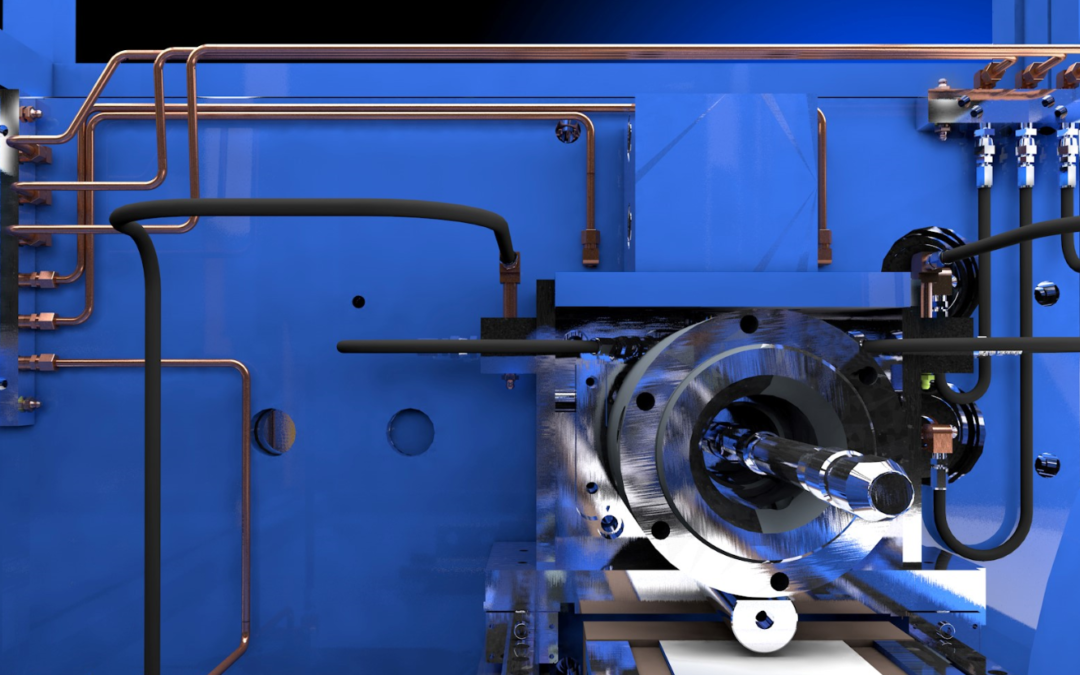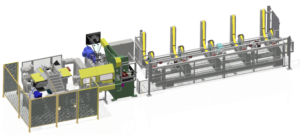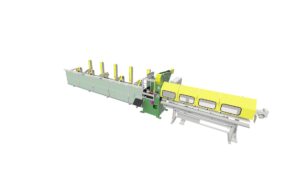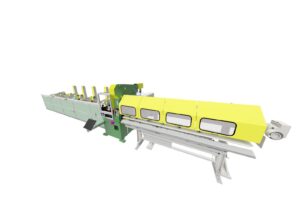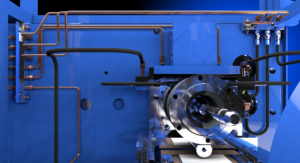Introduction of High-Speed Tube Cutting
The history of high-speed tube cutting dates back to the early 1960s, when laser cutting technology was first developed. Initially, laser cutting was mainly used for industrial applications such as cutting sheet metal. Over time, the technology was refined, and its applications expanded to include tube cutting. Since then, other high-speed tube-cutting technologies, such as shear and plasma cutting, have been developed, further improving the speed and precision of the cutting process. Today, high-speed tube-cutting technology continues to evolve, with advancements in automation, intelligent cutting technologies, and adaptive cutting systems.
High-speed tube cutting means using advanced technologies to cut cylindrical objects such as pipes, tubes, and bars at high speeds with precision and accuracy. This technique is widely used across various industries, including automotive, construction, furniture, and others. This technique enables the production of high-quality cuts in a fraction of the time required by conventional cutting methods.
High-Speed Tube Cutting Technology
High-speed tube cutting technologies include shear, laser, saw, and plasma cutting. Each technique has unique advantages and limitations, making it suitable for different applications.
Shear Cutting
Shear cutting is a technology used in high-speed tube cutting. It involves using a shear blade to cut through the tube, moving along a fixed path while it rotates. The cutting action is similar to that of scissors or a paper cutter.
The main advantage of shear cutting is its ability to produce clean and accurate cuts at a high rate of output. The shear blade is designed to make precise cuts with minimal burrs or deformation, resulting in high-quality finished parts.
Some advantages of tube shearing saw, laser and abrasive cutting methods:
Cost-effectiveness: Tube shearing is generally a more cost-effective method saw, laser and abrasive cutting methods. It does not require as much specialized equipment, and the process is simpler and faster, which often results in lower costs.
High-speed cutting: Tube shearing is an extremely fast cutting, which makes it a great option for high-volume production.
Minimal material waste: Tube shearing produces minimal material waste, as the cutting blades are designed to cut as close to the edge of the material as possible, reducing scrap and increasing efficiency.
Versatility: Tube shearing can be used on a wide range of materials, including stainless steel, aluminum, and copper, and can handle a variety of tube shapes and sizes.
However, one limitation of shear cutting is that it may only be suitable for some materials. For example, brittle materials may crack or break during the cutting process, and shear cutting may not be the best choice for these materials. In addition, the cutting speed may be slower than other cutting technologies like laser cutting.
Laser Cutting
Laser cutting is a high-precision technique using a laser beam to melt or vaporize the material. The laser beam is guided by a computer program, which ensures precise cutting according to the desired design. For example, the laser beam is focused on the tube’s surface in tube cutting, creating a narrow kerf that results in a high-quality cut.
Laser cutting has several advantages, including high precision and flexibility. The technology can cut various materials, including metals, plastics, and ceramics, and produce complex shapes with high accuracy. Laser cutting is also non-contact, reducing the risk of material damage.
One of the main limitations of laser cutting is the high cost of equipment and maintenance. Also, laser cutting is unsuitable for cutting materials that reflect light or absorb heat, which can cause the laser beam to deflect or scatter.
Saw Cutting
Saw cutting is a cutting technique that uses a rotating blade to cut through the material. The blade is guided by a computer program that controls the cutting speed and angle. Saw cutting is commonly used for cutting metal tubes, and the resulting cut has a smooth surface finish.
Saw cutting is a cost-effective method that can quickly process large volumes of material. It is also suitable for cutting materials of different thicknesses and sizes. In addition, saw cutting is relatively simple and can be used for cutting straight or angled cuts.
Saw cutting has some limitations, including limited precision compared to laser cutting, and the resulting cut may require additional processing to achieve the desired surface finish. Additionally, saw cutting produces heat, which can cause material deformation or warping.
Plasma Cutting
Plasma cutting is a technique that uses a high-velocity jet of ionized gas to melt and cut through the material. The plasma jet is guided by a computer program, which controls the cutting speed and angle. Plasma cutting is commonly used for cutting metal tubes, and the resulting cut has a smooth surface finish.
Plasma cutting is a cost-effective method that can quickly process large volumes of material. It is suitable for cutting materials of different thicknesses and sizes, and the resulting cut has a smooth surface finish. Plasma cutting is also versatile and can be used for cutting various materials, including metals, plastics, and ceramics.
One of the main limitations of plasma cutting is its limited precision compared to laser cutting. Since plasma cutting produces heat, it can cause material warping and deformation leading to imprecise cuts. Plasma cutting is also unsuitable for cutting materials that do not conduct electricity, such as glass or wood.
Applications of High-Speed Tube Cutting
High-speed tube-cutting technologies are widely used across various industries, including automotive, furniture, racking, construction, etc.
Automotive industry
The automotive industry is one of the main users of high-speed tube-cutting technology. Tube cutting is used for manufacturing various automotive components, including exhaust systems, roll cages, and structural components. High-speed tube cutting is preferred for its speed, precision, and ability to produce complex shapes.
Furniture Industry
The furniture industry also uses high-speed tube cutting for manufacturing various products, including chairs, tables, and frames. Tube cutting allows for precise cuts and complex shapes, enabling furniture manufacturers to create innovative designs.
Racking Industry
The racking industry uses high-speed tube cutting for manufacturing various storage systems, including shelves, racks, and cabinets. Tube cutting allows for precise cuts and complex shapes, enabling manufacturers to create custom storage solutions.
Tube Producers / Recut Facilities
Tube producers and recut facilities use high-speed tube cutting for processing tubes into desired lengths and shapes. This enables them to produce tubes that meet specific customer requirements, such as custom lengths or angles.
Construction Industry
The construction industry uses high-speed tube cutting for manufacturing various components, including handrails, stairs, and structural components. Tube cutting allows for the production of precise cuts and complex shapes, enabling construction companies to create custom solutions for their projects.
Other Applications
High-speed tube cutting is also used in various other applications, including medical equipment manufacturing, aerospace component manufacturing, and industrial equipment manufacturing. In these applications, tube cutting enables the production of precise cuts and complex shapes, which are essential for creating high-quality products.
Factors Affecting High-Speed Tube Cutting
Several factors influence high-speed tube cutting, including material properties, machine parameters, and environmental conditions. Understanding these factors is essential for achieving the desired cutting results.
Material Properties
Type of Material
The type of material being cut is a critical factor in high-speed tube cutting. Different materials have varying properties, such as melting points, reflectivity, and conductivity, which can affect the cutting process. For example, stainless steel and aluminum materials require different cutting parameters than mild steel.
Diameter
Additionally, the diameter of the tube is an important consideration. Different diameter tubes may require different cutting parameters to achieve the desired cut quality and accuracy. For example, cutting thin-walled tubes with a small diameter may require different cutting parameters than thicker-walled tubes with a larger diameter. The tube size can also affect the stability of the material during the cutting process, as smaller-diameter tubes may be more prone to vibrations and movement.
Thickness
The thickness of the material being cut is also an important factor. Thicker materials require more power and slower cutting speeds to achieve a clean cut. On the other hand, thinner materials can be cut at faster speeds.
Hardness
The hardness of the material being cut can also affect the cutting process. Harder materials require more power and slower cutting speeds to achieve a clean cut. Cutting hard materials can also result in increased tool wear and reduced tool life.
Machine Parameters
Speed
The cutting speed of any machine is an important parameter in high-speed tube cutting. Higher cutting speeds result in faster cutting times but can also lead to reduced cutting quality. Optimal cutting speeds depend on several factors, including the material’s type and thickness, the cutting technology being used, and the desired cutting quality.
Accuracy
The accuracy of the cutting process is another important machine parameter. Cutting accuracy is affected by several factors, including machine positioning accuracy, tool wear, and material deformation during cutting. Therefore, maintaining cutting accuracy is essential for achieving consistent cutting results.
Environmental Factors
Temperature
The cutting environment’s temperature can impact the cutting machines’ performance and the cut’s quality. For example, high temperatures in the cutting area can cause thermal expansion in the machine components, affecting their accuracy and performance.
In addition, the temperature of the material being cut can also affect the cutting process. Some materials, such as metals, can become more difficult to cut at higher temperatures, while others, such as plastics, can become softer and more prone to deformation.
Humidity
Humidity can also affect the cutting process. High humidity can cause rust and corrosion on the cutting equipment, affecting cutting quality and machine life. Therefore, proper humidity control is necessary for maintaining cutting quality and equipment longevity.
Air Quality
Air quality is an important factor in high-speed tube cutting. Dust and debris in the air can accumulate on the cutting equipment and affect cutting quality. Therefore, proper air filtration and ventilation are necessary for maintaining cutting quality and machine life.
Benefits Provided by Advancements in High-Speed Tube Cutting
High-speed tube cutting has seen significant advancements in recent years, driven by the demand for faster and more efficient cutting processes. Here are some of the latest advancements in high-speed tube cutting:
Automation
Automation is becoming increasingly popular in high-speed tube cutting. Automation systems can control various aspects of the cutting process, including material handling, cutting speed, and cutting quality. Automated systems can also reduce the risk of operator error and increase productivity by allowing the machine to run continuously.
Intelligent Cutting Technologies
Intelligent cutting technologies use advanced software and sensors to monitor the real-time cutting process. These systems can adjust cutting parameters on the fly to ensure consistent cutting quality, even when cutting materials with varying properties. Intelligent cutting systems can also reduce scrap and material waste by optimizing the cutting path to minimize material usage.
Adaptive Cutting Systems
Adaptive cutting systems use advanced sensors and algorithms to adjust the cutting process in real time based on the material properties and cutting conditions. These systems can adjust cutting speed, power, and other parameters to achieve optimal cutting quality while minimizing tool wear and material waste. Adaptive cutting systems can also reduce setup time and increase cutting throughput by automatically adjusting the cutting process based on the cut material.
Overall, these advancements in high-speed tube-cutting technology are driving improvements in cutting quality, speed, and efficiency, making high-speed tube-cutting more accessible and affordable for a wider range of applications.
High Speed Tube Cutting at Haven Manufacturing
High-speed tube cutting is a critical process in many industries, and advancements in cutting technology have made it more accessible and efficient.
Haven manufacturers the most robust and dependable machines on the market, and the widest range of custom designed machine solutions to fit many applications. For more information about our machines or to discuss your high speed tube cutting needs please contact us today.

